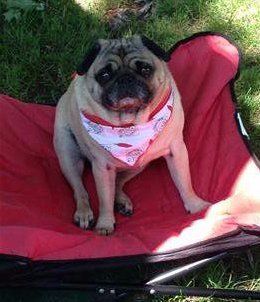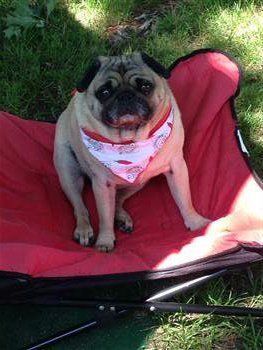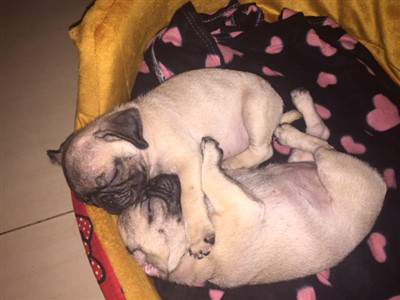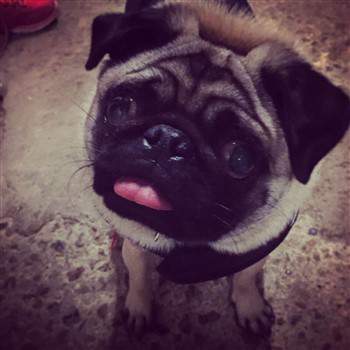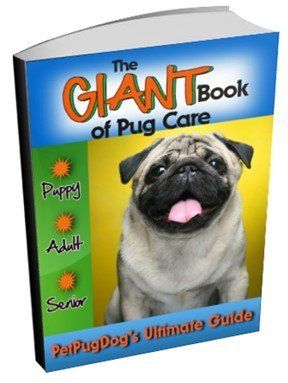When a Pug Dog is Always Hungry
Overview
While there are just as many Pug dogs that are finicky with food as there are that have a ferocious appetite that cannot be satisfied, the Pug breed does tend to get a lot of focus for this particular issue. And it is wise for owners to take notice.
Being the largest of all toy breeds, at an adult weight of 14 to 18 pounds (6.35 to 8.16 kg) a Pug does need to eat a moderate amount of food just to maintain.
However, with his barrel shaped body and being a brachycephalic (flat faced) breed, any extra weight caused by overeating can lead to an increase in breathing problems and other issues.
In addition, if a Pug seemingly always want to eat, this can point to needed changes in the type of food that is being offered and possibly to a need to reassess owner reaction to such begging behaviors.
This section will take a look at all that is involved with Pugs that are always hungry, to help sort out if the dog’s appetite is actually normal or if this is a red flag of needing to make a change.
Please note:
PetPugDog is reader-supported, and some of the product suggestions on this page may be affiliate links. As an Amazon Associate we earn from qualifying purchases. This is at no extra cost to you and helps keep this site running.
A Note About Puppies
It typical and expected for a Pug puppy to have a big appetite that levels off at the 9 to 10-month mark.
In fact, for toy breeds like the Pug, the first 11 weeks are a time of exponential growth with gains of an average of 13 to 17% body weight.
And it is food that fuels this. Puppies will need to eat more food (per pound of body weight) than their adult counterparts. Therefore, while other elements such as quality of food should be looked at, it is normal for a Pug puppy to eat quite a bit.
In cases when a puppy is eating adequate amounts but is not gaining as expected, though it is important to have all health issues ruled out, including worms, this may be a matter of the body not absorbing nutrients as it should.
If so, speak to you vet about adding a prozyme supplement to aid the digestive tract and better absorb the nutrients he is ingesting.
Frog, at 6 years old
Photo courtesy of the Benjamin's
Overeating and Gaining Weight Vs Overeating without Change
A huge factor and method of figuring out why a Pug may be constantly hungry is to assess if the food that he is eating is actually affecting his weight. And in this regard, we’ll discuss adult Pugs (1 year and older), since growth of course, is expected with
puppies.
As we move forward, please note that each reason for increased appetite and the ways to resolve it will depend on if there is a change in the Pug's weight.
The 6 Top Reasons a Pug dog May Always Be Hungry
#1 Quality of Food.
If a Pug is constantly hungry, eating a lot (as an adult) and this is not causing him to gain weight, this may point to a problem with his food. And the culprit here is cheap dog food that contains fillers.
Fillers are very inexpensive ingredients that hold no nutritional value, they do, however, as the name implies, ‘fill’ up the food. It plumps it up to make it appear as if there is a lot of food. However, these worthless components pass right through the body.
They offer nothing. No vitamins. No protein. Not even any calories.
Depending on the percentage of the fillers, a dog may only ingest 1/4 to 3/4 cup real food in a 1 cup serving. So, as you can imagine, eating servings of ‘nothing’ can certainly lead to a Pug feeling hungry soon after a meal.
What to do:
1.
Reassess what you are feeding your Pug for his main meals. You’ll want it to be a 4 or 5 star food. Once you get to a 3 star and certainly 2 and 1 stars, those will contain fillers, along with other detrimental elements such as by-products and chemicals (coloring, flavoring, preservatives).
We recommend Orijen, which is a 5 star made of wholesome ingredients such as chicken, whole herring, turkey, green peas, pumpkin, squash, lentils and squash. It has a good protein to carb to health fat ratio. Wellness Core is an excellent choice as well.
You may wish to read more about what to feed a Pug
or, if you want to check out your Pug’s food rating, you can look to Dog Food Advisor, which allows you to search for just about any brand.
2.
You may want to start adding your own wholesome, fresh ingredients to offer your Pug more substance and nutrition, which will more adequately satisfy his appetite and hold him over much better until the next meal.
Some great additions include low-cal veggies such as green beans, carrots and peas and some fruit, which is very low in calories and high in water content, yet most Pugs find delicious such as banana, strawberries, blueberries and raspberries.
#2 Meal Size.
If meals are too small, a Pug may gobble down the food and be hungry again soon afterward.
Most owners go ahead and feed their dog a snack or even two. Then comes dinner and once again the meal is smaller than needed, so the dog eats that up and since it doesn’t fill him up enough, he’s looking for treats soon afterward. In a case such as this, it will appear that the Pug is constantly looking for food and needs to eat every hour or two.
Even with being hungry around the clock, since he is being fed what he actually needs (though too frequently), most Pugs will not gain excess weight from this. However, there are exceptions; if a Pug is looking for a morsel and is given 3 or 4, this sort of thing can cause a gradual weight gain
over the course of weeks or months.
What to do:
This is just a matter of needing to increase portion size for scheduled meals. Once that is done, the need for continual treats will be abated. It should be noted that bloat
can happen with this breed; most cases of bloat happen due to a dog eating too fast, not too much.
For this reason, do be sure to use a slow-feeder bowl or place a portion pacer in the bowl; this will encourage your Pug to eat at a reasonable pace.
Wanting to know exactly how much food to give to dogs is very common; however, the answer will vary immensely depending on the brand and type. With wet, dry and freeze-dried, moderate quality and high quality and different protein sources (chicken, fish, etc.), it’s impossible to say ‘a half cup’ or ‘two cups’.
You’ll want to carefully read the labeling on the package of the brand that you are giving to your Pug; it will be fairly accurate for most dogs.
Baxter, "Will You Be My Valentine", at 2 years old
Photo courtesy of Leigh from North Carolina
If you are giving home cooked food, a good rule of thumb is to give a Pug 20 minutes to have his fill.
#3 Begging.
There is always that first time that a dog begs for a treat and the owner gives in. It’s all done innocently; mostly in part because the owner had no idea that their dog would even remember the event. Another reason why owners may cave in is guilt; why should a Pug have to be ‘stuck’ with dog food?
After all, what harm can come from giving him a piece of ‘real’ food. However, when it comes to treats, having an owner give in to one begging session is all that’s needed for a dog to establish that begging works.
Sometimes, a dog isn’t even hungry when he does this. Something smells
good. Or he loves the ‘game’ using expression and actions to ‘receive reward’. In either case, this can get out of control with the dog asking for food all of the time and his human giving it to him.
What to do:
Do be sure to evaluate main meals to ensure that the Pug is receiving enough nutrients. With that in place, it will be time to stop the begging behavior. Everyone in the household should be on the same page, so that a Pug does not learn that if he doesn’t get something from one person, all he must do is go to the next person.
Then, a feeding schedule should be planned and followed. Most adult Pugs do well with 2 meals per day. Snacks should definitely be given, but these should be reserved to reward good behavior such as going to the bathroom in the right spot or listening to a command.
It takes some willpower, however if an owner stands firm and does not give in, a dog will learn that the ‘game’ of begging won’t be played any longer. It can also help to offer something nice that is not food related. You can make your Pug happy by playing fetch or being taken for an extra walk.
#4 Because it’s there.
This may seem too obvious, but in some cases a Pug will seem to be hungry all the time simply due to endless food stimulation.
Lucu and Gemes (both 4 months old)- they are sisters!
Photo couresty of Lenny van Es-Sinaga
from Jakarta- Ibdonesia
If you prepare and cook food quite a bit and your Pug is there to smell it and see it, it is canine instinct to try and get it!
Even if a dog is not hungry at all, it’s hard for him to ignore his canine senses. The interest that he shows may be mistaken for actual hunger.
What to do:
This one is a bit tricky, because you don’t want to have to hide when you prepare your dinners. If possible, you can try to time things so that another family member is taking your Pug for a walk while you prepare supper.
In some cases, if keeping your Pug away is unavoidable, it will be a matter of the owner learning to not take a Pug’s curiosity or instinct to be given food for genuine hunger. A low calorie treat such as flavored ice cubes can be given for a distraction.
#5 Changing needs.
A dog’s appetite can increase, slightly, all throughout the year due to various changes.
The weather plays a role to some degree; some dogs eat less in the summer
and more in the winter. Conversely, some dogs eat more in the summer due to increased activity and less in the winter
if they stay inside more often.
What to do: Assess your Pug’s recent activity level. This is a good way to make sure that you are staying on track in regard to your dog getting enough exercise. If he has been more active, know that it’s normal for him to be hungrier.
#6 Illness or Other Health Issues.
While many health issues
will cause decreased appetite, there are some conditions to be aware of that can lead to a ravenous appetite, known as polyphagia. The most common issues seen with this breed include:
- Diabetes. This can develop in any dog at any age. Increased hunger is often seen at the onset of this disease.
- Worms. Roundworms, tapeworms and whipworms can all cause a dog to eat and never feel satisfied. In addition, any of these parasitic infections can also cause a pot-bellied appearance, so it may appear that the dog is gaining weight, when he in fact is not.
- Intestinal issues. Anything that disrupts the intestinal tract can cause a dog’s body to have trouble absorbing nutrients. When that happens, the dog can eat quite a bit but still be hungry all of the time, because despite what he is ingesting, his body is not receiving what it needs. There is a wide range of conditions under this category including irritable bowel disease and even cancer.
What to do: Even if your Pug just recently had a wellness check, do bring him to the vet if you have made the applicable changes listed here but there is no improvement. We recommend that all owners budget away money so that vet visits are not a financial burden and to never procrastinate should a health concern be suspected; early diagnosis is key for good prognosis and a speedy recovery.
Olly, at 18 months old
Photo courtesy of Sam Tucker - Kent, UK
If Your Pug is On a Diet But is Hungry All The Time
It can be hard to put a Pug on a diet (often on the advice of a vet who has determined that the dog needs to lose some weight since obesity is a problem with this breed), because it's hard to see a Pug being hungry all the time.
However, there are two things you can do and both involve allowing a dog to eat as much as he used to; it will only involve a lower number of calories.
First, you'll want to speak to the vet about possibly switching to a variety that contains less calories; these are often labeled as 'weight control' or 'healthy weight'; however do be sure to check the brand's ranking, since some contain much too much carbs.
In addition to that or in place of that, you can switch out some of the kibble in each meal for lower calorie foods and especially those with fiber to help keep a dog satiated. A great choice is peas (we recommend the frozen type); these have 7 grams of protein and 6 grams of fiber per cup and studies have shown that eating peas can reduce hunger.
Sweet potatoes have slowly digested complex carbohydrates and filling fiber. Steamed broccoli is fantastic, with only 15 calories in a half cup and a good amount of fiber, vitamin A and tons of vitamin C.
Fruits are great too! Choose high water content fruits like watermelon, blueberries, raspberries and strawberries. These can be frozen and
given as snacks or mixed into meals.
Want to stay informed?
Become a free PetPugDog Member
- This will allow you to receive newsletters that let you know about new Pug articles. You can also submit photos of your Pug that may be added to this site and suggest a topic for us to write about.


